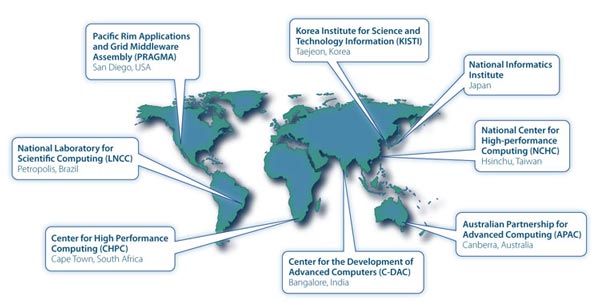There are eight articles describing activities in Australia, Brazil, India, Japan, Korea, South Africa, Taiwan, and the Pacific Rim Applications and Grid Middleware Assembly (PRAGMA).

- The Australian Partnership for Advanced Computing (APAC) leads the Australian National Grid Program. John O’Callaghan describes the APAC and its vision for providing advanced computing, information and grid infrastructure for the Australian research community through the APAC National Grid Program. This program encompasses the national facilities at APAC and the distributed partner sites, supporting distributed research on national and international levels. As you will read, the advanced communication infrastructure that is in place in Australia offers many opportunities for international collaborations.
- Brazilian efforts are described by Marco Raupp et al. in "Cyberinfrastructure supporting multidisciplinary science in Brazil." The authors provide a short history of the high-end computing and the national networking infrastructures, discuss the recent upgrades and the current environment that exists, highlight activities in the development of cyberenvironments, and touch upon some critical applications.
- India’s emerging nation-wide computational grid "GARUDA," which aims to aggregate distributed resources of research and academic institutions, is described by Mohan Ram and S. Ramakrishnan. The article describes the architecture and the major components of GARUDA—the grid resources, network, middleware, data management, and portals. The authors also point to a couple of sample applications of national importance in India—sensor networks and bioinformatics—that will be tackled using this infrastructure.
- Japan’s Cyber Science Infrastructure (CSI)—the next generation academic information environment, coordinated by the National Institute of Informatics in collaboration with Japanese universities and academic institutions—is described by Masao Sakauchi et al. They describe Japan’s academic networking and National Research Grid Initiative (NAREGI) as well as the provision of academic digital content for CSI.
- Korea’s effort in the construction and utilization of cyberinfrastructure and its current status is described by Hyeongwoo Park et al. The phenomenal strides in broadband deployment and adoption in Korea and the advantages it provides for establishing a grid infrastructure, supporting middleware development, and for undertaking cutting-edge research in grids are described. The authors also discuss some sample e-Science projects.
- South Africa’s article, "HPC in South Africa: Computing is support of African Development" by Rob Adam et al., describes the objectives and structure of the Center for High Performance Computing (CHPC) as an arm of the Meraka Institute that facilitates needs-based research and innovation. They discuss current progress in the establishment of CHPC, and its implications for linking research and innovation in addressing the needs of the South African society and economy with further reach into the continent of Africa and the world.
- "The Taiwan Cyberinfrastructure for Knowledge Innovation" article by Whey-Fone Tsai et al. addresses how Taiwan’s twin projects, Knowledge Innovation National Grid (KING) and Advanced Research and Education Network (TWAREN), form the kernel of Taiwan’s cyberinfrastructure and enable science and engineering innovation. The authors describe their development and deployment efforts in the various components of the cyberinfrastructure and in enabling grid applications in sensor networks and in ecological and environmental domains as well as community health.
- Last but not least, in "PRAGMA: Example of Grass-Roots Grid Promoting Collaborative e-Science Teams," Peter Arzberger and Phil Papadopoulos outline the unique membership-partnership activities under the auspices of PRAGMA – the Pacific Rim Applications and Grid Middleware Assembly. They illustrate the potential of bringing resources, tools and research teams from around the world to create, support and sustain international science and technology collaboration, and the challenges associated with making this a reality on a routine basis. PRIME and PRIUS are some of the major activities spearheaded by PRAGMA that involve the next generation of students.
Enabling innovation and breakthrough science seem to be unifying themes across all institutions. Applications with a broader societal impact—health and human life, drug design and discovery, bioinformatics, weather forecasting, climate change, environmental modeling, disaster management and mitigation, natural language processing, collecting, analyzing, mining and visualizing large volumes of data, and so on—are where most of the demands and interest in the development and establishment of cyberinfrastructure rest.
The world’s treasure is its people. Together, we can do ordinary things in extraordinary ways and can make the whole greater than the sum of the parts. All of the articles in this issue of CTWatch Quarterly are a testament to the extraordinary opportunities that exist for global collaborations and for joining together in addressing frontier research problems in science and engineering, problems that will have long-term societal impacts. Working together, we can truly create a cyberinfrastructure that will emphasize that "we are in one world" and "it is a small world."
Please read on.
2 access.ncsa.uiuc.edu/Releases/01.27.06_NCSA_dedic.html
3 www.ctwatch.org/quarterly/archives/november-2005
Pages: 1 2






